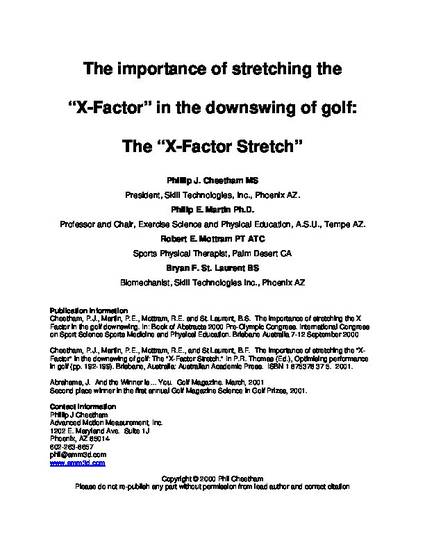
Contribution to Book
The Importance of Stretching the "X-Factor" in the Downswing of Golf: The "X-Factor Stretch".
Optimizing Performance in Golf
(2001)
Abstract
The “X-Factor” is a popular term for the relative rotation of shoulders with respect to hips during the golf swing. A relatively large X-Factor at top of backswing is thought to facilitate high club head speed at impact. Little consideration, however, has been given to how the X-Factor changes early in the downswing. We tested the hypotheses that highly skilled golfers have a higher X-Factor at the top of the backswing and a greater increase in the X-Factor early in the downswing (“X-Factor Stretch”) than less skilled golfers. Multiple swings of 10 highly skilled (handicap 0 or better plus one long drive champion) and 9 less-skilled (handicap ≥ 15) golfers were captured with a SkillTec 3D-Golf™ swing analysis system (Skill Technologies Inc., Phoenix AZ). The X-Factor was measured at the top of backswing and at its maximum in the downswing. A contrast of the X-Factor means at the top of backswing showed no significant difference between the highly skilled and less skilled golfers, (t=1.017, p=0.326). Further, the effects of skill level (highly skilled and less skilled) and swing position (top and maximum) on the X-Factor were assessed using a two-factor ANOVA. The X-Factor averaged for both the top and maximum was 11% higher in highly skilled golfers than the less-skilled players, but this difference was not statistically significant (group main effect F1,17=1.93, p=.18). The X-Factor Stretch occurred during the early stages of the downswing for both highly skilled and less skilled golfers (swing position main effect F1,17=131.57, p<.001), but was significantly greater for the highly skilled players (19%) than the less skilled golfers (13%; group x swing position interaction F1,17=6.90, p=.02). This suggests X-Factor Stretch early in the downswing is more important to an effective swing than simply the X-Factor at the top of backswing.
Disciplines
Publication Date
March, 2001
Editor
P.R. Thomas
Publisher
Australian Academic Press
ISBN
1 875378 37 5. 20013
Publisher Statement
2000 Australian Academic Press. Posted with permission.
Citation Information
Phillip J. Cheetham, Philip E. Martin, Robert E. Mottram and Bryan F. St. Laurent. "The Importance of Stretching the "X-Factor" in the Downswing of Golf: The "X-Factor Stretch"." BrisbaneOptimizing Performance in Golf (2001) p. 192 - 199 Available at: http://works.bepress.com/philip_martin/5/
